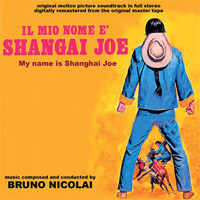- Composed by Bruno Nicolai
- GDM Hillside / 2014 / 37m
A spaghetti western released in 1972, Mario Caiano’s Il Mio Nome e’ Shangai Joe sees a Chinese immigrant (Chen Lee) arrive in Texas and be greeted with less-than-open arms. He finds himself caught up in a battle to free enslaved Mexicans from their cruel master. It’s not generally considered to be very good, but I would love to see it, since the film features characters called False Teeth and Pedro the Cannibal; and frankly it’s hard to imagine that any film featuring characters called False Teeth and Pedro the Cannibal could be anything less than a masterpiece.
Bruno Nicolai’s excellent score opens with “Il mio nome”, a typical spaghetti western theme introduced by fluttering flutes before electric and acoustic guitars, Alessandroni’s choir and an explosive trumpet solo carry the dynamic melody forward. It’s a wonderful theme, propulsive and exciting as all the best themes in this genre tend to be. “La partenza” is a little more restrained, featuring a chilled-out melody for organ accompanied by more guitars, this time with drums and a distant choir; almost lounge music-like really, but soothing and relaxed and very attractive.
“Sfida” is a more complex piece, dreamy winds leading into a kaleidoscopic passage featuring organ and percussion which is beautifully dreamlike, becoming ever more dramatic and intense. The most attractive theme is the gorgeous “Richiami d’amore”, sunny strings soaring away carrying a melody with a distinctly south-of-the-border flavour. It’s such a lovely piece, one to light the darkest of days. “L’allegro becchino” is a jaunty little piece whose clip-clop style inevitably recalls Ennio Morricone’s Cheyenne theme from Once Upon a Time in the West. “Nubi” is at the less attractive end of the scale, dissonant string and piano textures creating a particularly tense atmosphere.
“Il Giuramento” sees the darkness continue, but this time there’s an interesting twist with a lilting melody playing over the top of the starkest of backdrops; it’s ingenious stuff, very impressive. “Shanghai Joe” presents a far darker take on the main theme than heard when it was introduced earlier, but it’s interesting because from that hard-as-nails start the track features the almost comically-clichéd first “Chinese” music for the main character. Clichéd it may be – but also massively entertaining.
“Caccia all’uomo” is an impressionistic piece featuring fascinating wind textures and more dissonance. The laid-back feel from earlier in the score is reintroduced in “Remoto”, a brief but lovely moment of calm. The calm doesn’t last – “Alternativa” has a definite edge to it, with a certain jazz influence. “Abissale” – the only previously-unreleased track – is actually one of the score’s finest moments, a lovely set of variations on the main theme. “Saloon” does what you expect it to; who doesn’t love a bit of honky-tonk? “Attimi” is another atmospheric track, little piano and brass phrases bursting forth from the slightly unsettling quiet of the strings and dreamy winds, before the score concludes with a terrific reprise of the main theme. It’s a very entertaining one, highly recommended to anyone who likes spaghetti western scores, with an array of excellent material from start to finish.
Rating: ****
facebook.com/moviewave | twitter.com/MovieWaveDotNet | amazon.com













This music is fantastic, but it’s an almost direct copy of Nicolai’s earlier score for ‘Buon Funerale Amigos! … Paga Sartana’.
A sudden proliferation of limited edition BRUNO NICOLAI scores, and now your “Il mio nome e’ Shangai Joe” review James, prompted me to revisit my collection of NICOLAI soundtracks. During the late ’60s & ’70s, NICOLAI’s name was twinned with that of ENNIO MORRICONE’s > ENNIO the maestro composer & BRUNO his score conductor…. and the results were sensational….an era that celebrated MORRICONE’s most remarkable and timeless music! As well as being an imaginative & techno-savvy conductor, NICOLAI was also a composer > his better works very influenced by the innovative genius of the MORRICONE scores he was conducting. Regrettably [and, of course, unfairly] for NICOLAI, it would always be MORRICONE’s original stylizations, orchestrations and experimental sonics that would eclipse NICOLAI’s compositions… as happens with “Shangai Joe”! NICOLAI’s score has all the derived trademarks of a signature MORRICONE Western > the melodies are lovely but are cloned from the MORRICONE template, as are the rhythms, orchestrations & artistés. Because of its derived status, the score was lucky to receive so many stars! I noticed lots of harpsichord instrumentation in this score and, coincidentally, NICOLAI is the harpsichord performer on MARIO NASCIMBENE’s “La Regazza con la Valigia” [“Girl with a Suitcase”, the cult CLAUDIA CARDINALE movie]. This guitar & harpsichord score has beautiful baroque flavoured melodies that contrast with a Brasilian cha-cha-cha, ’50s vintage rock ‘n roll, folk songs & DIMITRI TIOMKIN’s Deguello theme. A NICOLAI score that ISN’T influenced by MORRICONE is “Vita di MichelAngelo”…it features some very beautiful Renaissance styled melodies – without the ethnic period instruments though, that would have elevated the music to more critical acclaim. I haven’t heard the additional tracks on the new CD release – maybe these are orchestrated with period instruments.
I do not agree at all that this score (or any other western by Nicolai) merely is a derivation of Morricone’s trademarks. I find it very easy to recognize typical “Nicolai-isms” in Nicolai’s westerns/scores and typical “Morricone-isms” in Morricone’s westerns/scores, so Nicolai’s westerns confidently stand on their own.